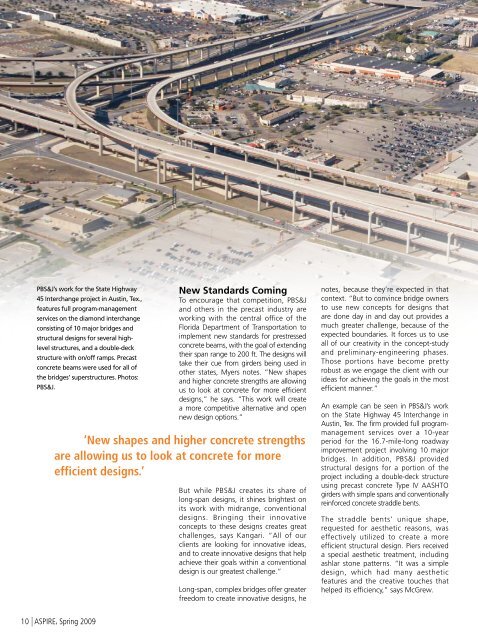ASPIRE Spring 09 - Aspire - The Concrete Bridge Magazine
ASPIRE Spring 09 - Aspire - The Concrete Bridge Magazine
ASPIRE Spring 09 - Aspire - The Concrete Bridge Magazine
Create successful ePaper yourself
Turn your PDF publications into a flip-book with our unique Google optimized e-Paper software.
PBS&J’s work for the State Highway<br />
45 Interchange project in Austin, Tex.,<br />
features full program-management<br />
services on the diamond interchange<br />
consisting of 10 major bridges and<br />
structural designs for several highlevel<br />
structures, and a double-deck<br />
structure with on/off ramps. Precast<br />
concrete beams were used for all of<br />
the bridges’ superstructures. Photos:<br />
PBS&J.<br />
New Standards Coming<br />
To encourage that competition, PBS&J<br />
and others in the precast industry are<br />
working with the central office of the<br />
Florida Department of Transportation to<br />
implement new standards for prestressed<br />
concrete beams, with the goal of extending<br />
their span range to 200 ft. <strong>The</strong> designs will<br />
take their cue from girders being used in<br />
other states, Myers notes. “New shapes<br />
and higher concrete strengths are allowing<br />
us to look at concrete for more efficient<br />
designs,” he says. “This work will create<br />
a more competitive alternative and open<br />
new design options.”<br />
‘New shapes and higher concrete strengths<br />
are allowing us to look at concrete for more<br />
efficient designs.’<br />
But while PBS&J creates its share of<br />
long-span designs, it shines brightest on<br />
its work with midrange, conventional<br />
designs. Bringing their innovative<br />
concepts to these designs creates great<br />
challenges, says Kangari. “All of our<br />
clients are looking for innovative ideas,<br />
and to create innovative designs that help<br />
achieve their goals within a conventional<br />
design is our greatest challenge.”<br />
Long-span, complex bridges offer greater<br />
freedom to create innovative designs, he<br />
notes, because they’re expected in that<br />
context. “But to convince bridge owners<br />
to use new concepts for designs that<br />
are done day in and day out provides a<br />
much greater challenge, because of the<br />
expected boundaries. It forces us to use<br />
all of our creativity in the concept-study<br />
and preliminary-engineering phases.<br />
Those portions have become pretty<br />
robust as we engage the client with our<br />
ideas for achieving the goals in the most<br />
efficient manner.”<br />
An example can be seen in PBS&J’s work<br />
on the State Highway 45 Interchange in<br />
Austin, Tex. <strong>The</strong> firm provided full programmanagement<br />
services over a 10-year<br />
period for the 16.7-mile-long roadway<br />
improvement project involving 10 major<br />
bridges. In addition, PBS&J provided<br />
structural designs for a portion of the<br />
project including a double-deck structure<br />
using precast concrete Type IV AASHTO<br />
girders with simple spans and conventionally<br />
reinforced concrete straddle bents.<br />
<strong>The</strong> straddle bents’ unique shape,<br />
requested for aesthetic reasons, was<br />
effectively utilized to create a more<br />
efficient structural design. Piers received<br />
a special aesthetic treatment, including<br />
ashlar stone patterns. “It was a simple<br />
design, which had many aesthetic<br />
features and the creative touches that<br />
helped its efficiency,” says McGrew.<br />
10 | <strong>ASPIRE</strong>, <strong>Spring</strong> 20<strong>09</strong>

















